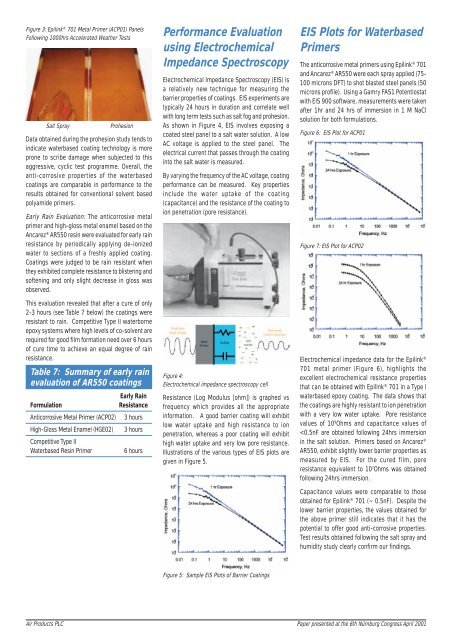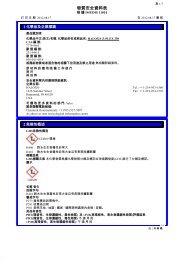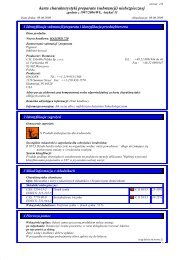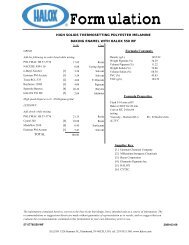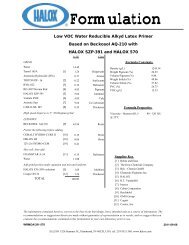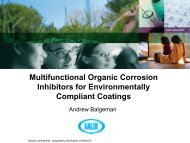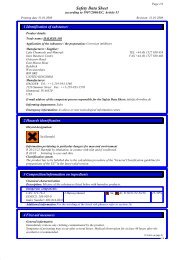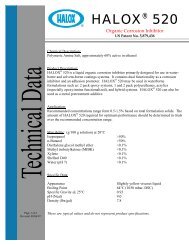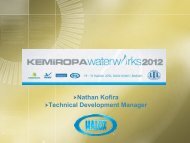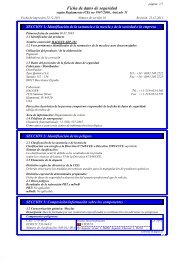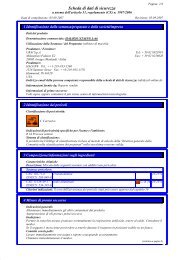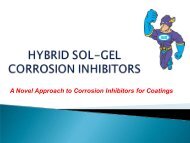Formulating novel aqueous epoxy - Halox
Formulating novel aqueous epoxy - Halox
Formulating novel aqueous epoxy - Halox
- No tags were found...
You also want an ePaper? Increase the reach of your titles
YUMPU automatically turns print PDFs into web optimized ePapers that Google loves.
Figure 3: Epilink ® 701 Metal Primer (ACP01) PanelsFollowing 1000hrs Accelerated Weather TestsSalt SprayProhesionData obtained during the prohesion study tends toindicate waterbased coating technology is moreprone to scribe damage when subjected to thisaggressive, cyclic test programme. Overall, theanti-corrosive properties of the waterbasedcoatings are comparable in performance to theresults obtained for conventional solvent basedpolyamide primers.Early Rain Evaluation: The anticorrosive metalprimer and high-gloss metal enamel based on theAncarez ® AR550 resin were evaluated for early rainresistance by periodically applying de-ionizedwater to sections of a freshly applied coating.Coatings were judged to be rain resistant whenthey exhibited complete resistance to blistering andsoftening and only slight decrease in gloss wasobserved.This evaluation revealed that after a cure of only2-3 hours (see Table 7 below) the coatings wereresistant to rain. Competitive Type II waterborne<strong>epoxy</strong> systems where high levels of co-solvent arerequired for good film formation need over 6 hoursof cure time to achieve an equal degree of rainresistance.Table 7: Summary of early rainevaluation of AR550 coatingsEarly RainFormulationResistanceAnticorrosive Metal Primer (ACP02) 3 hoursHigh-Gloss Metal Enamel (HGE02) 3 hoursCompetitive Type IIWaterbased Resin Primer 6 hoursPerformance Evaluationusing ElectrochemicalImpedance SpectroscopyElectrochemical Impedance Spectroscopy (EIS) isa relatively new technique for measuring thebarrier properties of coatings. EIS experiments aretypically 24 hours in duration and correlate wellwith long term tests such as salt fog and prohesion.As shown in Figure 4, EIS involves exposing acoated steel panel to a salt water solution. A lowAC voltage is applied to the steel panel. Theelectrical current that passes through the coatinginto the salt water is measured.By varying the frequency of the AC voltage, coatingperformance can be measured. Key propertiesinclude the water uptake of the coating(capacitance) and the resistance of the coating toion penetration (pore resistance).Figure 4:Electrochemical impedance spectroscopy cellResistance (Log Modulus [ohm]) is graphed vsfrequency which provides all the appropriateinformation. A good barrier coating will exhibitlow water uptake and high resistance to ionpenetration, whereas a poor coating will exhibithigh water uptake and very low pore resistance.Illustrations of the various types of EIS plots aregiven in Figure 5.EIS Plots for WaterbasedPrimersThe anticorrosive metal primers using Epilink ® 701and Ancarez ® AR550 were each spray applied (75-100 microns DFT) to shot blasted steel panels (50microns profile). Using a Gamry FAS1 Potentiostatwith EIS 900 software, measurements were takenafter 1hr and 24 hrs of immersion in 1 M NaClsolution for both formulations.Figure 6: EIS Plot for ACP01Figure 7: EIS Plot for ACP02Electrochemical impedance data for the Epilink ®701 metal primer (Figure 6), highlights theexcellent electrochemical resistance propertiesthat can be obtained with Epilink ® 701 in a Type Iwaterbased <strong>epoxy</strong> coating. The data shows thatthe coatings are highly resistant to ion penetrationwith a very low water uptake. Pore resistancevalues of 10 9 Ohms and capacitance values of


